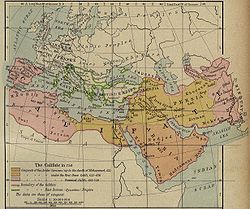- Ya'qub-i Laith Saffari
-
Ya'qub bin Laith as-Saffar o Ya'qub-i Laith Saffari o, simplemente, Saffar (840-879) (persa یعقوب لیث صفاری ) fue el fundador de la dinastía safárida en Sistán, con su capital en Zaranj (una ciudad que hoy está en el Sur-Oeste de Afganistán). Gobernó territorios que hoy están en Irán, Afganistán y Pakistán.[1] [2]
Contenido
Vida temprana
Ya'qub's nació en una familia plebeya de Qarnin, una pequeña aldea en Sistán. Se movió a la ciudad de Zaranj y trabajó el cobre, mientras su hermano Amr-i Laith Saffari (quien más tarde se convirtió en su sucesor) trabajó alquilando mulas.[3] Comenzó su campaña como bandolero (Ayyar) La traducción exacta de "ayyar" no es realmente bandido sino más bien una especie de protectores de los pobres y buscadores de la libertad pues no hay traducción directa de este término en muchos idiomas lo más cercano sería algo así como "caballero" que con su lealtad y valentía podían proteger a los pobres y formaba su propio ejército.[1] En las historias del folclore iranio, Ya'qub es considerado un Robin Hood iranio debido a que robaba a los ricos para ayudar a los pobres.[1]
Dinastía safárida
Llamó la atención del califato abasí al conquistar territorios no musulmanes en el Este, que ahora son en su mayor parte de Afganistán y Pakistán. Entonces comenzó a actuar como un gobernante independiente y con el tiempo tuvo éxito al ganar control de mucho de lo que hoy es Irán, Afganistán y grandes partes de Pakistán. Se convirtió en el monarca soberano de la primera dinastía irania después de la conquista islámica árabe.[1] [2] En muchos casos, los pueblos que conquistaba se habían rebelado contra sus señores islámicos y vuelto a formas precedentes de religión.[4]
De su capital Zaranj, conquistó una vasta región que incluyó: el valle de Kabul, Sind, Tocaristán, Makrán (Beluchistán), Kermán, Fars y Jorasán. Intentó conquistar Bagdad pero fue derrotado por las fuerzas del califa al-Mu'tamid.[1] [2] Fue durante su gobierno que el persa fue introducido como un idioma oficial, acabando con la influencia invasiva del idioma árabe.[5] Laith ha alcanzado el rango de héroe popular histórico debido a que en su corte comenzó la revitalización del persa después de dos siglos de dominación árabe.[2]
Véase también
Notas
- ↑ a b c d e «"Ya'qub-i Laith Saffari"». Encyclopædia Britannica Online. Consultado el 15-07-2007.
- ↑ a b c d «"Saffarid Dynasty"». Encyclopædia Britannica Online. Consultado el 15-07-2007.
- ↑ «"YA'QUB LAYT"». Encyclopædia Iranica. Consultado el 15-07-2007.
- ↑ Dupree, Nancy Hatch (1971) "Sites in Perspective (Chapter 3)" An Historical Guide To Afghanistan Afghan Tourist Organization, Kabul, OCLC 241390
- ↑ Hafizullah Emadi. Culture and Customs of Afghanistan, Greenwood Press, 2005. pg 27
Categorías:- Gobernantes de Irán
- Gobernantes de Afganistán
- Gobernantes de Pakistán
- Nacidos en 840
- Fallecidos en 879
- Dinastía safárida
Wikimedia foundation. 2010.

